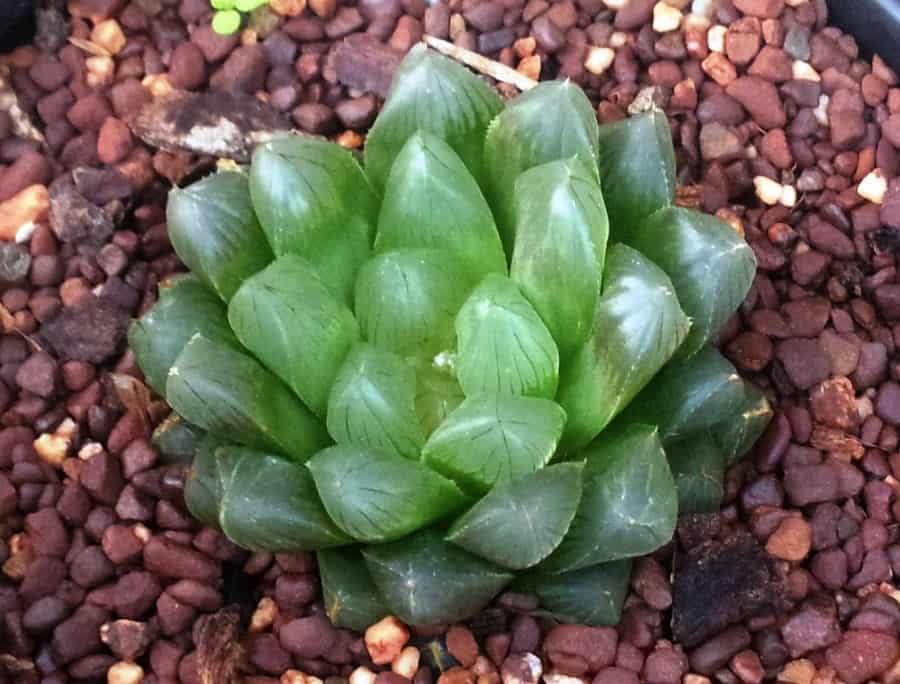Haworthia cooperi var. truncata is native to South Africa.
Most of its stem is buried in nature, with only the tip being the only exposed part.
This serves two purposes:
1. Protects the plant from the sun and heat.
2. It allows photosynthesis
This succulent has round, grape-shaped leaves and thin skin lined with clear veins.
It is usually teal in color with translucent leaves.
This small plant is slow-growing and does not even reach a height of 7.5 cm.
Despite being almost transparent, they are easy to grow and are rarely affected by pests.
Its roots are strong and tolerant.
It forms dense clusters when they bloom, the flowers being simple and white. They are born from the inflorescence.
It blooms from spring to summer; it has a single inflorescence peduncle, about 30 cm long.
The petals and sepals are strongly reflected; they are bluish-greenish-white, with medium stripes of green to greenish-brown.
However, no one cultivates these plants for their flowers.
Haworthia Cooperi var. truncata Care:
Illumination
Being a rather small plant, you can place it in the garden, patio or terrace.
Of course, in any case, it has to be in an area where it can get sunlight.
And make sure it enjoys partial shade.
Substratum
It grows in sandy, and even rocky areas.
If it’s in the garden, make sure it’s well-drained. If necessary, mix the soil with 50% perlite, clay, volcanic clay, or similar.
If it’s on the pot, it will be ok; you can mix with perlite or river sand mixed in equal parts.
In either case, it is a good idea to add a layer of gravel to the bottom to reduce the soil’s absorption action.
Watering
The irrigation frequency of the Haworthia cooperi will almost always be the same.
It is necessary to water considerably less during the fall and winter, but in general, with one or two irrigations a week, it will be fine.
If you live in an area where frost occurs, give it water once a month.
And by the way, when you water, do it to the soil, never the plant; otherwise, it could be sunburned or rot.
Fertilizer
To keep the plant healthy and well-fed, I recomend to fertilized during spring and summer you can do it every month, try using a liquid ffertilizer mix with the water.
In fall and winter, do not fertilize.
Diseases
Howorthias cooperi is usually free of pests.
You can eliminate or combat these diseases with insecticides.
But it’s main enemy is the erwinia carotovora bacteria affecting in most cases when the plant is in tropical climates; this bacteria kills the plant in a few weeks.
If you detect this disease, you must initially eliminate the most infected parts, usually located at the roots.
A red-hot knife or razor should be applied to the bacteria’s wounds to cauterize the root wounds.
In addition, introduce the plant roots, for a few minutes, in a solution of water and vinegar, so that we ensure their disinfection.
Transplant
It should be done only in spring.
If it’s in a pot, it has to be transplanted every two years when is young.
Once it reaches its final size, it will be enough to renew the substrate every 3 or 4 years.
Propagation
The Haworthia cooperi multiplies by seeds and by shoots in spring-summer. Let’s see how to proceed in each case:
Seeds
The first thing you should do is prepare a tray for seeds or a pot and fill it with a mixture of black peat, river sand, and universal substrate.
Then, the substrate should be watered thoroughly.
The next step is to spread the seeds, taking care that they are not piled up.
Once the seeds are scattered, it is time to cover them with a light layer of black peat, but remember that it is a very light layer, just to cover the seeds.
Once you have done all this, you should place the tray or the pot in a very bright place but never receiving direct sunlight.
The seeds will germinate in 2-3 weeks.
Once the plant starts rooting, you can plant the plant in the pot.
Shoots
The shoots can be separated from the mother plant when they are easily manipulated, such as about 3 to 4 cm.
Then they are planted in individual pots.
Pruning
Does not require pruning. Just remove the dry leaves.
Temperature
They do not usually withstand temperatures below 5ºC/41°F in winter. I recommend you don’t expose this plant to a temperature below 10ºC/50°F in winter.
For the plant’s proper development and growth, the ideal would be that it was always at a warm temperature.
